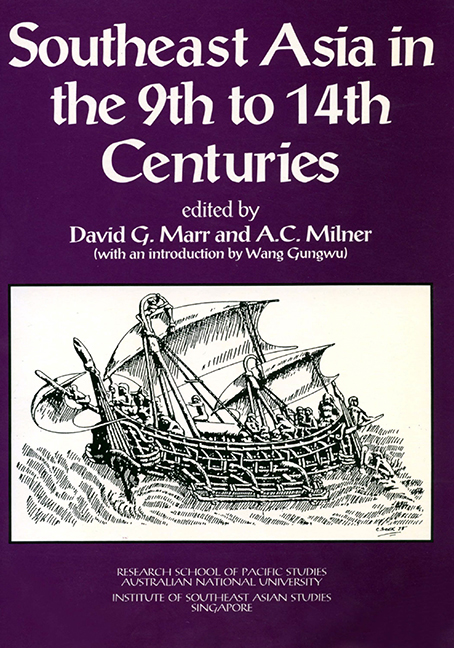Book contents
- Frontmatter
- Contents
- Contributors
- Preface
- Introduction
- 1 The Early and the Imperial Kingdom in Southeast Asian History
- 2 Hydraulic Works and South East Asian Polities
- 3 Some Notes on Relations between Central and Local Government in Ancient Java
- 4 Negara, Mandala, and Despotic State: Images of Early Java
- 5 Some Remarks on Early State Formation in Cambodia
- 6 “Elephants Can Actually Swim”: Contemporary Chinese Views of Late Ly Dai Viet
- 7 Authority and Legitimacy in 11th Century Vietnam
- 8 From Myth to History: Imagined Polities in 14th Century Vietnam
- 9 Shipshape Societies: Boat Symbolism and Political Systems in Insular Southeast Asia
- 10 Changing Perspectives in Island Southeast Asia
- 11 Political and Cultural Continuities at Dvaravati Sites
- 12 The True and the Corbel Arch in Mainland Southeast Asian Monumental Architecture
- 13 Vietnamese Ceramics and Cultural Identity: Evidence from the Ly and Tran Dynasties
- 14 Traditions, Acculturation, Renovation: The Evolutional Pattern of Vietnamese Culture
- 15 Symbolism of Kingship in Arakan
- 16 Buddhism in Champa
- 17 The Ordering of Generations: Change and Continuity in Old Javanese Kinship
- 18 Sources on Economic Activities in Khmer and Cham Lands
- 19 Narrative Bas-Reliefs at Candi Surawana
- 20 Possibilities for a Reading of the 1293-1357 Period in the Vietnamese Annals
- Index
- Miscellaneous Endmatter
1 - The Early and the Imperial Kingdom in Southeast Asian History
Published online by Cambridge University Press: 21 October 2015
- Frontmatter
- Contents
- Contributors
- Preface
- Introduction
- 1 The Early and the Imperial Kingdom in Southeast Asian History
- 2 Hydraulic Works and South East Asian Polities
- 3 Some Notes on Relations between Central and Local Government in Ancient Java
- 4 Negara, Mandala, and Despotic State: Images of Early Java
- 5 Some Remarks on Early State Formation in Cambodia
- 6 “Elephants Can Actually Swim”: Contemporary Chinese Views of Late Ly Dai Viet
- 7 Authority and Legitimacy in 11th Century Vietnam
- 8 From Myth to History: Imagined Polities in 14th Century Vietnam
- 9 Shipshape Societies: Boat Symbolism and Political Systems in Insular Southeast Asia
- 10 Changing Perspectives in Island Southeast Asia
- 11 Political and Cultural Continuities at Dvaravati Sites
- 12 The True and the Corbel Arch in Mainland Southeast Asian Monumental Architecture
- 13 Vietnamese Ceramics and Cultural Identity: Evidence from the Ly and Tran Dynasties
- 14 Traditions, Acculturation, Renovation: The Evolutional Pattern of Vietnamese Culture
- 15 Symbolism of Kingship in Arakan
- 16 Buddhism in Champa
- 17 The Ordering of Generations: Change and Continuity in Old Javanese Kinship
- 18 Sources on Economic Activities in Khmer and Cham Lands
- 19 Narrative Bas-Reliefs at Candi Surawana
- 20 Possibilities for a Reading of the 1293-1357 Period in the Vietnamese Annals
- Index
- Miscellaneous Endmatter
Summary
The early States of Southeast Asia were equipped by modern historiography with more or less all Weberian criteria of a modern State. Accordingly, these early States were governed by the kings through a central administrative staff which was able to uphold successfully the legitimate claim of the monopoly of physical force within a given area.[1] Successful pillages of neighbouring areas were therefore often understood as annexations and rather vague tributary relations were interpreted as an indicator of the existence of an hierarchicallystructured system of provinces and districts etc.
Let me illustrate this interpretation of early Southeast Asian history by two examples selected from two certainly “unsuspicious” authors whose works are still regarded as standard works. About early Funan L.P. Briggs wrote in the year 1951: “From a little river-settlement governed by a naked girl, to an empire more than a thousand miles in extent, with boundaries perhaps as wide as those of which the proudest Khmer Emperor could later boast, in less than two centuries, is no small achievement for any people in any period.”[2]Recent research however, particularly by C. Jacques, has shown that nearly none of these statements can be accepted any longer as established facts.[3] Funan's history neither began as a river settlement under the legendary naked Naga princess, nor do we have any proof that the alleged conquests of the Funanese King Fan Shi-Man led to a permanent annexation of areas far beyond the Mekong and even Menam delta.
The other example refers to the famous quotation from the New History of the Tang about the kingdom of Holing which most probably was located in Java. The relevant passage in the Hsin T'ang shu is as follows: “on the borders [of Ho-ling] there are 28 small countries, all of which owe allegiance to Ho-ling. There are 32 great ministers and the Ta-tso-kan-hsiung is the chief of them.”[4] Heine-Geldern, in his even more famous article on “Conceptions of State and Kingship in Southeast Asia”, quoted this passage to illustrate the cosmic role of kings, courts and governments in Southeast Asia.
- Type
- Chapter
- Information
- Southeast Asia in the 9th to 14th Centuries , pp. 1 - 22Publisher: ISEAS–Yusof Ishak InstitutePrint publication year: 1986



